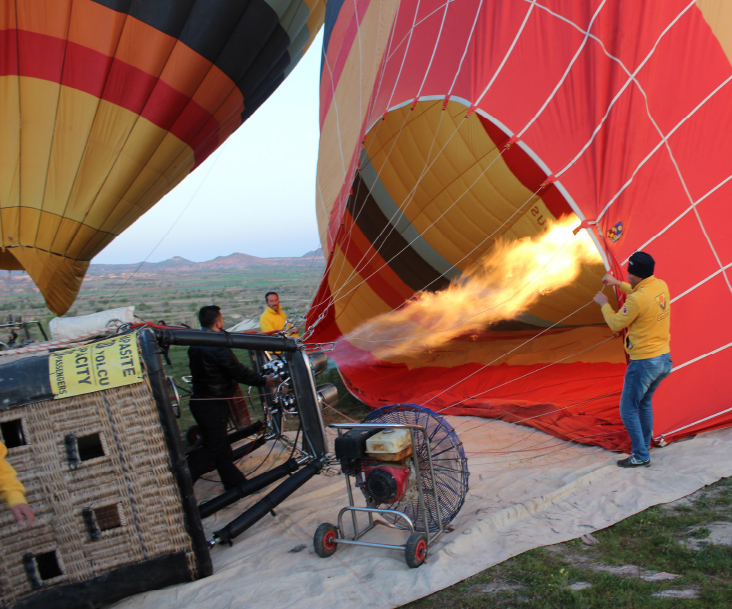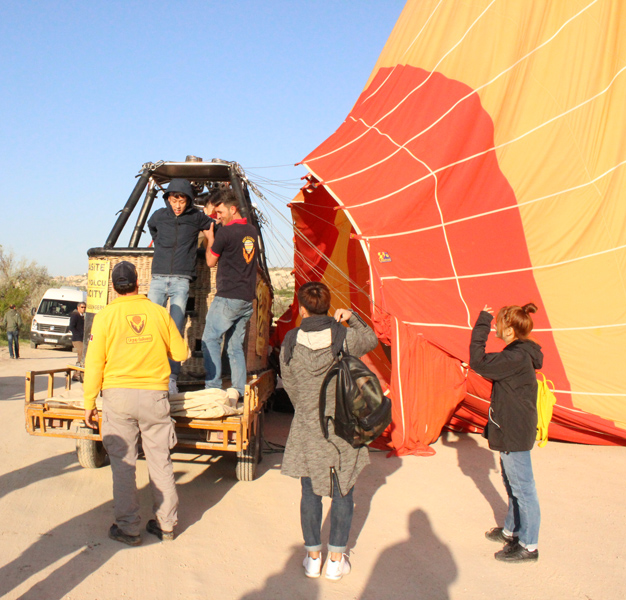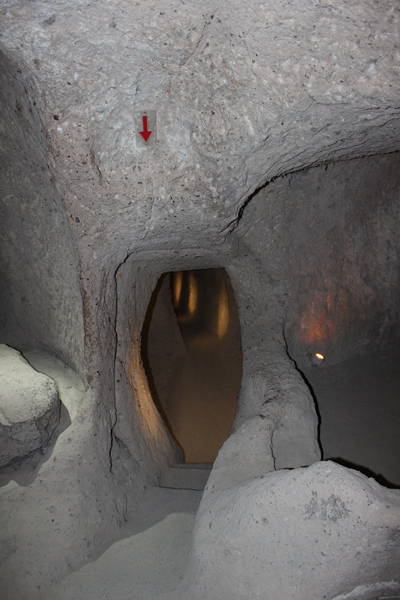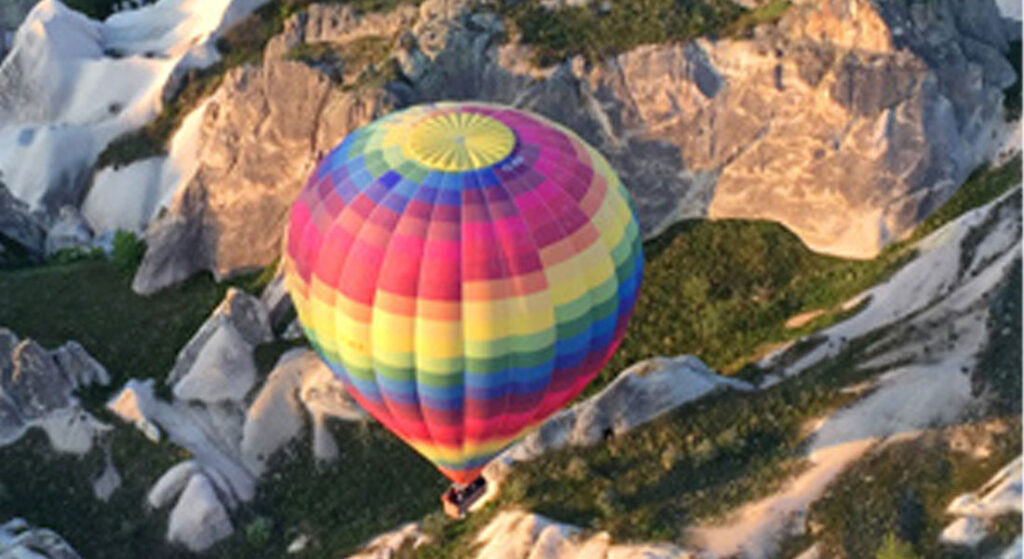
When you plan a holiday in Turkey, a must is of course the historic city of Istanbul, the capital of the Ottoman Empire (renamed from Constantinople). But having seen, over the years, glorious pictures of hot air balloon rides over the steep, slender and naturally eroded rock formations in Cappadocia in the Anatolian region of south west Turkey, a balloon experience was a must on our itinerary. In Turkish Cappadocia means “the land of beautiful horses.”
But an added incentive was the opportunity to stay in a “cave hotel”, of which there are plenty in the region. These are actually cut out of caves, and provide a combination of modern comforts with a feeling of living in a bygone era.
A flight to the Sabiha Gokche airport in Istanbul and then a short hour-long domestic flight to Kayseri brought us close to the town of Urgup, which we reached after a 60-minute coach ride. But as it was almost close to midnight, and after a gruelling six-hour wait at the Sabiha airport, as we got dropped to the Best Western Premium Hotel, we had no idea of our magical surroundings — the beautiful landscape and the rocky formations done over millions of years of volcanic activity.
Cappadocia gives you an opportunity to stay in cave hotels, which are actually cut out of caves. These provide modern comforts with a feeling of living in a bygone era.
The towns of Kayseri, Nevsehir, Urgup and Ortahisar are the main ones in this region. Kayseri is located at the foot of the extinct volcano Mount Erciyes, soaring 3,900 metres above the town and is topped with snow in April.
Our main attraction is the hot air balloon ride, which can cost between $175 to 250, depending on your tour operator and the number of people who are put into the wicker basket, attached to the bottom at the balloon.

Crack of dawn
Sleepy-eyed, we are up at 4 a m to be picked up from our hotel at the crack of 4.30 a m; it is biting cold with the temperature being 8 deg Celsius. A 30- minute ride to the balloon operator’s office — there are several in this area — where we are given a light breakfast and taken to the take-off region. The sun has already come up and we can see in the horizon at least 100-odd balloons that are either up in the air, or preparing to take off.
The balloon starts rising, with the liftoff being unimaginably gentle, and within 15 minutes we are towering above the steep-edged rocks in the huge valley.
We march towards our balloon, having already been briefed to keep a good five-metre distance from the huge contraption as a fan blows air (propane gas) into the balloon. Simultaneously the gas is being heated by a burner; it is the heated propane which makes the balloon rise. But flying the balloon is a tricky and intricate job, and our Pilot Mehmet confidently and skillfully steers his “spaceship” in the air. But not before we have been briefed to be very careful when the balloon lands. “Hold on to the braces fixed to the sides in the basket, crouch on your knees because the basket will land sideways and only after that it will be turned upright”, we are told.
It sounds easy enough, and more than anything else, we are all eager to begin our 60-minute ride. Soon the balloon starts rising, with the liftoff being unimaginably gentle, and within 15 minutes we are towering above the steep-edged rocks in the huge valley. By now the sky is dotted with a couple of hundred balloons and the landscape below is a sight to die for! The golden glow of the morning sun lights up the entire valley with its rock formations, pigeon-holed caves, and the mushroom-shaped fairy chimneys.
The underground cities were made by troglodytes (cave dwellers) during the Bronze age and later occupied by the Christians in the third century when they fled from the Roman rulers.
Fairy chimneys
There is an interesting story behind the formation of the fairy chimneys, though nothing supernatural is involved! The chimneys are a result of a geologic process that began millions of years ago, when volcanic eruptions rained ash across the region and this gradually hardened into a soft, porous rock covered by a layer of basalt. Over millennia of erosion, the softer portion wore off, leaving behind pillars of different shapes and sizes, many of them as tall as 130 ft. The harder basalt eroded more slowly, forming a mushroom-shaped cap over each one. As they appear nothing less than magical, they are called fairy chimneys.

The balloon gently made its way over the valley, every now and then starting to descend slowly, when the pilot infused short spells of heat into the balloon to make it rise up once again. By skillfully tugging onto the ropes provided inside, Mehmet expertly steered the balloon forward and thus we flew, aided by the gentle wind — we were really lucky to have a calm day, as a rough patch of weather can give you some unpleasant bumps and jerks. On a real rough and windy day the balloon rides are cancelled and the money is refunded.

With a whacky sense of humour, the pilot announced that we were now nearly 1,500 ft above the ground level, adding in the next breath, “Have you heard of the Titanic?” As the women giggled nervously, he added, “Is this your first flight?”. As we nodded, he added, “Mine is second!”!
A few times he allowed the balloon to descend nearly 20–50 ft above the top of the chimneys, and often took us down to the depths of the valley. But at no time did we feel frightened, probably because the weather gods decided to play fair.

Gentle landing
Soon, too soon, it is time to touch terra firma, and the landing is quite a process for the organisers. A long pick up truck appears as the balloon comes down, follows it for a few minutes, and four strong-armed men hang on to the ropes dangling from the basket, and gently pull the balloon down, guiding it to make a perfect landing on the carriage of the pick up truck. There is no need to brace or squat and we make a gentle landing standing up and are helped out of the basket one after another.
As promised, the champagne toast ceremony begins. Popping the bottle open ceremoniously, the Captain dampens the spirits by announcing that the champagne is non-alcoholic! But we all make a toast and gulp it down. There is another surprise for us; there is a honeymooning couple in our basket and a cake is brought to the table, cut and devoured. The experience is concluded with each of us being given a medal!
Underground cities
The next day we make a trip to the underground cities Kaymakli and Derinkuyu, which were made by the troglodytes (cave dwellers) during the Bronze age and later occupied by the Christians in the third century when they fled from the Roman rulers. We crouch and weave our way around the low and narrow tunnels, minding the head all the time and discover the details of the dwelling, such as the kitchens, bedrooms, stables as well as churches.

In Derinkuyu, around 200 small ‘villages’ are spread over 160 sq km, complete with tunnels, hidden passageways, secret rooms etc. This city was at one time home to 20,000 residents living underground and was 11 levels deep.
As the rest of Turkey, Cappadocia too is a gourmand’s delight. We opt for different kinds of kebabs, prawns and fish, but for vegetarians too there is plenty of choice. And the good news for Indians, particularly South Indians, is that along with their delicious peta breads, the accompaniment of every dish is rice which is cooked with some kind of seed or the other.
As promised, Cappadocia proved to be a great destination, providing a great food experience too!
Pictures by Pervez Bhagat






